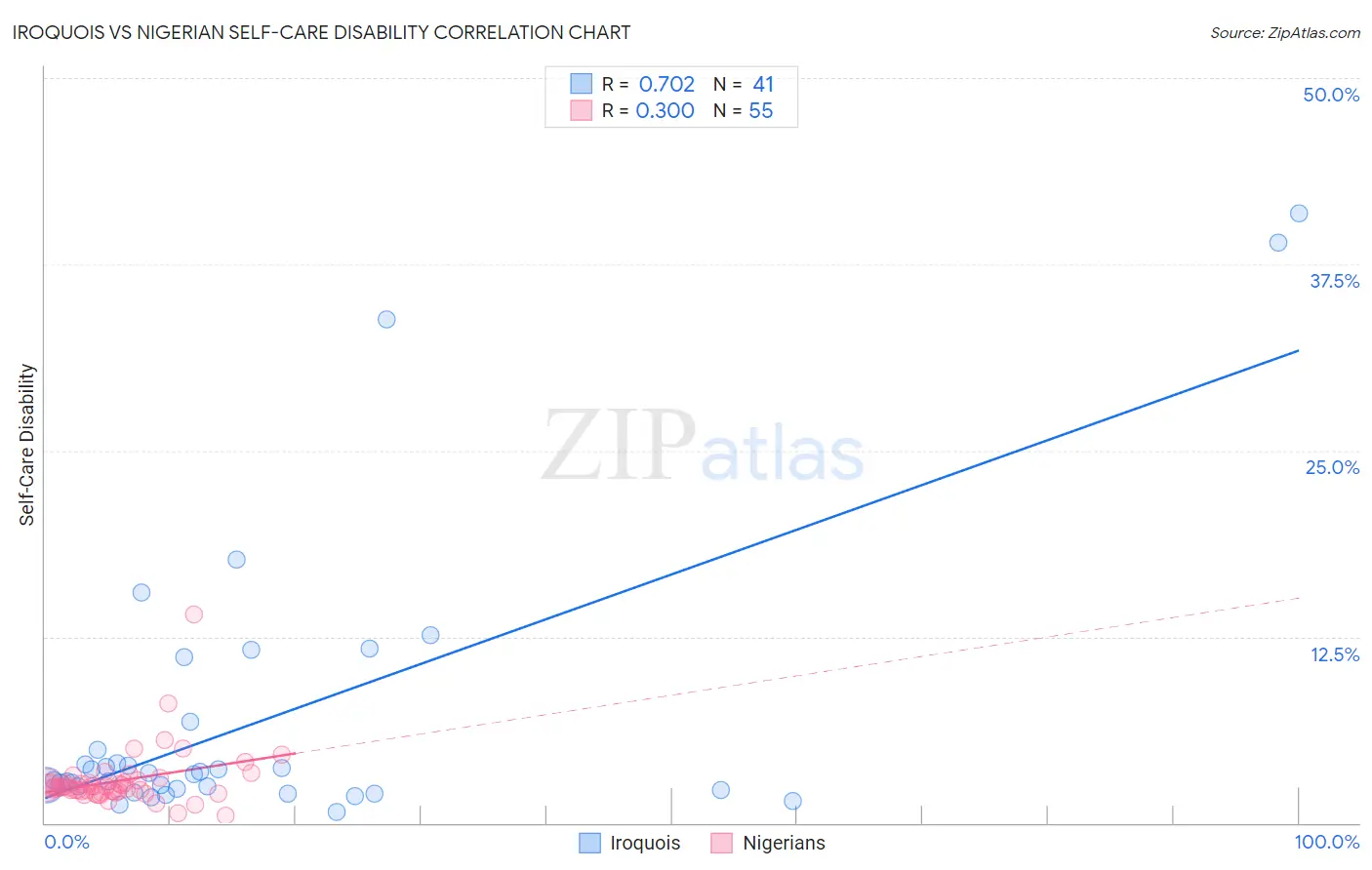Iroquois vs Nigerian Self-Care Disability
COMPARE
Iroquois
Nigerian
Self-Care Disability
Self-Care Disability Comparison
Iroquois
Nigerians
2.7%
SELF-CARE DISABILITY
0.1/ 100
METRIC RATING
279th/ 347
METRIC RANK
2.4%
SELF-CARE DISABILITY
70.6/ 100
METRIC RATING
156th/ 347
METRIC RANK
Iroquois vs Nigerian Self-Care Disability Correlation Chart
The statistical analysis conducted on geographies consisting of 207,147,261 people shows a strong positive correlation between the proportion of Iroquois and percentage of population with self-care disability in the United States with a correlation coefficient (R) of 0.702 and weighted average of 2.7%. Similarly, the statistical analysis conducted on geographies consisting of 332,359,271 people shows a mild positive correlation between the proportion of Nigerians and percentage of population with self-care disability in the United States with a correlation coefficient (R) of 0.300 and weighted average of 2.4%, a difference of 10.1%.

Self-Care Disability Correlation Summary
| Measurement | Iroquois | Nigerian |
| Minimum | 0.76% | 0.50% |
| Maximum | 40.9% | 14.0% |
| Range | 40.1% | 13.5% |
| Mean | 7.0% | 2.8% |
| Median | 3.3% | 2.4% |
| Interquartile 25% (IQ1) | 2.3% | 2.1% |
| Interquartile 75% (IQ3) | 5.9% | 2.7% |
| Interquartile Range (IQR) | 3.6% | 0.62% |
| Standard Deviation (Sample) | 9.7% | 1.9% |
| Standard Deviation (Population) | 9.6% | 1.9% |
Similar Demographics by Self-Care Disability
Demographics Similar to Iroquois by Self-Care Disability
In terms of self-care disability, the demographic groups most similar to Iroquois are Hispanic or Latino (2.7%, a difference of 0.020%), Ottawa (2.7%, a difference of 0.10%), Immigrants from Ukraine (2.7%, a difference of 0.18%), Immigrants from Iraq (2.7%, a difference of 0.18%), and Apache (2.7%, a difference of 0.20%).
| Demographics | Rating | Rank | Self-Care Disability |
| Immigrants | Laos | 0.1 /100 | #272 | Tragic 2.7% |
| Mexicans | 0.1 /100 | #273 | Tragic 2.7% |
| Yakama | 0.1 /100 | #274 | Tragic 2.7% |
| Immigrants | Trinidad and Tobago | 0.1 /100 | #275 | Tragic 2.7% |
| Japanese | 0.1 /100 | #276 | Tragic 2.7% |
| Immigrants | Ukraine | 0.1 /100 | #277 | Tragic 2.7% |
| Ottawa | 0.1 /100 | #278 | Tragic 2.7% |
| Iroquois | 0.1 /100 | #279 | Tragic 2.7% |
| Hispanics or Latinos | 0.1 /100 | #280 | Tragic 2.7% |
| Immigrants | Iraq | 0.0 /100 | #281 | Tragic 2.7% |
| Apache | 0.0 /100 | #282 | Tragic 2.7% |
| Delaware | 0.0 /100 | #283 | Tragic 2.7% |
| Fijians | 0.0 /100 | #284 | Tragic 2.7% |
| Jamaicans | 0.0 /100 | #285 | Tragic 2.7% |
| French American Indians | 0.0 /100 | #286 | Tragic 2.7% |
Demographics Similar to Nigerians by Self-Care Disability
In terms of self-care disability, the demographic groups most similar to Nigerians are Pakistani (2.4%, a difference of 0.050%), Immigrants from Europe (2.4%, a difference of 0.060%), Italian (2.4%, a difference of 0.090%), Immigrants from Western Europe (2.4%, a difference of 0.12%), and Immigrants from Italy (2.4%, a difference of 0.12%).
| Demographics | Rating | Rank | Self-Care Disability |
| Arabs | 75.7 /100 | #149 | Good 2.4% |
| Immigrants | Costa Rica | 75.1 /100 | #150 | Good 2.4% |
| Basques | 74.0 /100 | #151 | Good 2.4% |
| Tlingit-Haida | 73.5 /100 | #152 | Good 2.4% |
| Immigrants | England | 73.5 /100 | #153 | Good 2.4% |
| Italians | 72.2 /100 | #154 | Good 2.4% |
| Pakistanis | 71.4 /100 | #155 | Good 2.4% |
| Nigerians | 70.6 /100 | #156 | Good 2.4% |
| Immigrants | Europe | 69.6 /100 | #157 | Good 2.4% |
| Immigrants | Western Europe | 68.6 /100 | #158 | Good 2.4% |
| Immigrants | Italy | 68.5 /100 | #159 | Good 2.4% |
| Finns | 67.0 /100 | #160 | Good 2.4% |
| Lebanese | 66.5 /100 | #161 | Good 2.4% |
| Somalis | 63.7 /100 | #162 | Good 2.5% |
| German Russians | 62.7 /100 | #163 | Good 2.5% |